Review Meizu MX5: European quality from the Middle Kingdom
Every day, the number of Chinese manufacturers in the mobile device market is growing, new brands are appearing, and the old ones are consolidating their positions. The Meizu brand is one of the most successful players in this wave today. Over the past years, we were able to make sure that the company really knows how to make high-quality smartphones and delight users with a reasonable ratio of price and technical characteristics "on paper" with your favorite branded chips.
Less than a year ago after the successful launch of the Meizu Mx4 and its older sobart Meizu Mx4 Pro, June 30, 2015 was presented a new product - Meizu Mx5. This time the company focused on the needs and needs of users, and not just on the characteristics. The approach is correct, because today it is difficult to surprise someone with a fast processor or the amount of installed memory. But it is worth noting that the models of the Meizu MX line have never dropped into the segment of the average price, even in their homeland in China. In view of this, the smartphone fully lives up to consumer expectations, having in its arsenal an attractive feature set. And now, the smartphone is also officially delivered to the territory of the Russian Federation with all the advantages of legalized smartphones.

Before starting the Meizu Mx5 review, I suggest that you familiarize yourself with the list of technical specifications.
* Caution traffic
• Case materials: metal, glass (front panel - Gorilla Glass 3);
• Display: SuperAMOLED, diagonal of 5.5 ”inches, resolution 1920 x 1080 pixels, 406 ppi;
• Processor: eight-core MediaTek MT6795T, 64-bit, Cortex A53 at a frequency of 2.2 GHz, built on the Helio X10 Turbo platform;
• Video chip: PowerVR G6200 MP4, operating at a frequency of 700 MHz;
• Operating system: Android 5.0.1, Flyme 4.5 *;
• RAM: 3 GB;
• Memory for data storage: 16/32/64 GB, no microSD slot;
• Interfaces: Wi-Fi (ac / a / b / g / n) Dual-Band, Bluetooth 4.1 (LE), GPS (A-GPS support), Glonass, microUSB 2.0 connector (MHL, USB-OTG), AUX;
• Network: GSM / EDGE, UMTS / HSDPA, LTE (TD / FDD-LTE), (Dual SIM support);
• Main camera: 20.7 MP, Sony IMX230 sensor, f / 2.2 aperture, laser autofocus, dual LED flash. Ability to shoot video in 720 / 1080p and 4K;
• Front camera: 5 MP without autofocus, OV5670 sensor, f / 2.0 aperture, Ability to shoot video in 720 / 1080p;
• Sensors: fingerprint scanner (brand name mTouch 2.0), accelerometer, light sensor, proximity sensor;
• Battery: 3150 mAh;
• Dimensions: 149.9 x 74.7 x 7.6 mm;
• Weight: 149 grams.
Meizu MX5 comes in a new oversized package - 105 x 180 x 65 mm. The box is made of cardboard with a nice silky finish. Everything is very tightly fitted and getting to the contents is not an easy task.

What, in fact, is novelty? If you were previously familiar with Meizu products, then you will surely recall that all of the company's new products are packed in compact flat, square boxes. I’m not sure that the new solution can be called original and promising, rather intriguing. However, I note that in the supply for China, the smartphone comes without a box and is offered in the form of an improvised book with a cardboard cover. And the network charger is slightly different, sharpened for Chinese outlets.

There are at least inscriptions on the package - only the model name on top, the name of the manufacturer on the side and a neatly designed sticker on the bottom containing legal information about the product.
Inside, traditionally for the MX series, the smartphone lies in a kind of book combined with a brochure. The pages list the main advantages of the device, but for some reason in English ...
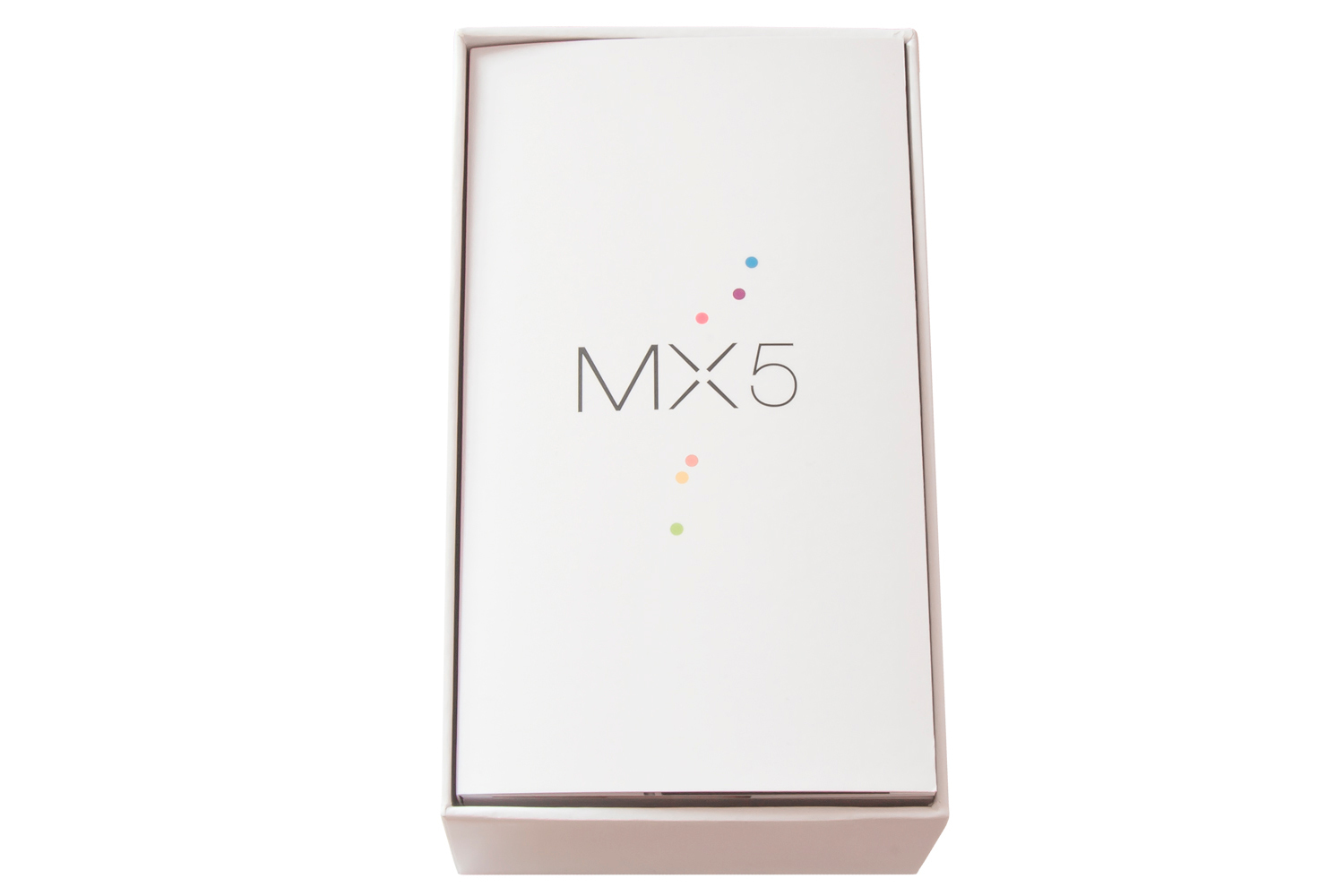



Under the “book” is a small paper folder with a company clip for removing the SIM tray and user documentation, which, incidentally, contains Russian in some places.


And here is the documentation itself:


In the depths, in a plastic bath, there is a small power adapter with an output current of two amperes and a classic USB cable version 2.0. And also a rather interesting plug in the place "under the headphones", which in the case of commercial deliveries are not equipped with the device. They can be purchased separately if desired. Officially presented two headsets - EP-21HD and EP-20S. They should be delivered in branded plastic boxes with a transparent front cover. All branded accessories are made in white colors.
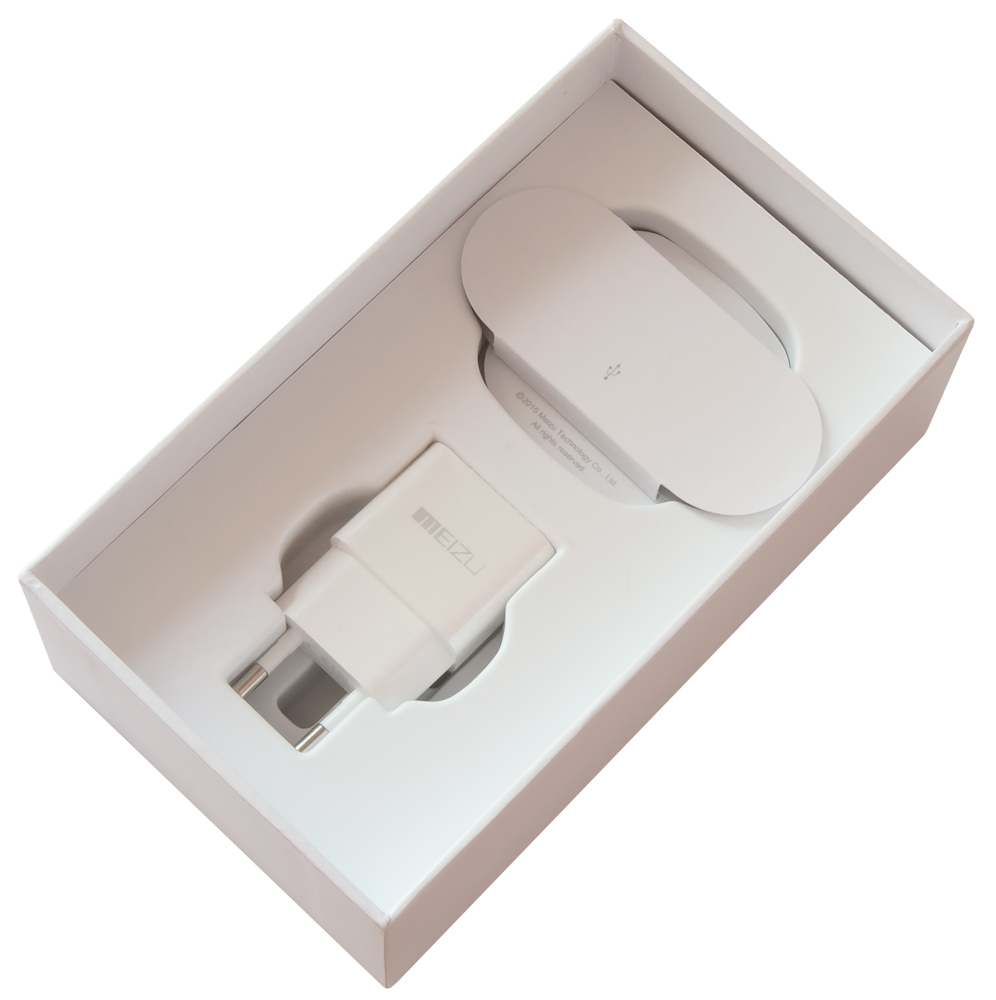


There are no complaints about the quality of manufacturing accessories, as well as the box. The smartphone is presented pretentiously and, I must say, it is deserved. In the end, you can only complain about the lack of a headset.
Design Meizu Mx5 certainly resembles its predecessor Meizu Mx4, but is not a direct copy. It is made in the classic monoblock form factor for the “gadgets” of recent years with a touch screen on the front side. At the same time, the corners of the case are rounded, the sides are sloping, and the “face” of the smartphone can be inadvertently confused with the Samsung Galaxy S6. But, upon closer examination, the appearance of the model, of course, looks more self-sufficient. Only the branded touch circle on the front side disappeared, but more on that later ... The

dimensions of the smartphone are 149.9 x 74.7 x 7.6 mm, weight - 149 g. The indentations from the display on top are 18.5 millimeters, below - 19.5 mm, on the sides about 3 mm.

With such dimensions and five and a half inches of the display, it is safe to say that the Meizu Mx5 has a very light and compact body. Everything is by the standards of the flagship. The smartphone has narrow frames and small indentation, comfortably lies in the hand. The device does not look like a classic “shovel”, both in small and medium hands. It affects the convenient shape of the rear panel and properly selected dimensions. It feels tactile in flagship and looks expensive. I can’t also name the smartphone soiled. The materials used are not wholly susceptible to rapid abrasion or scratching. I would compare those with the materials used to make MacBooks of the Air or Pro series. Only unlike the latter, the smartphone has several colors, namely four: gold with a golden back panel, white with silver,
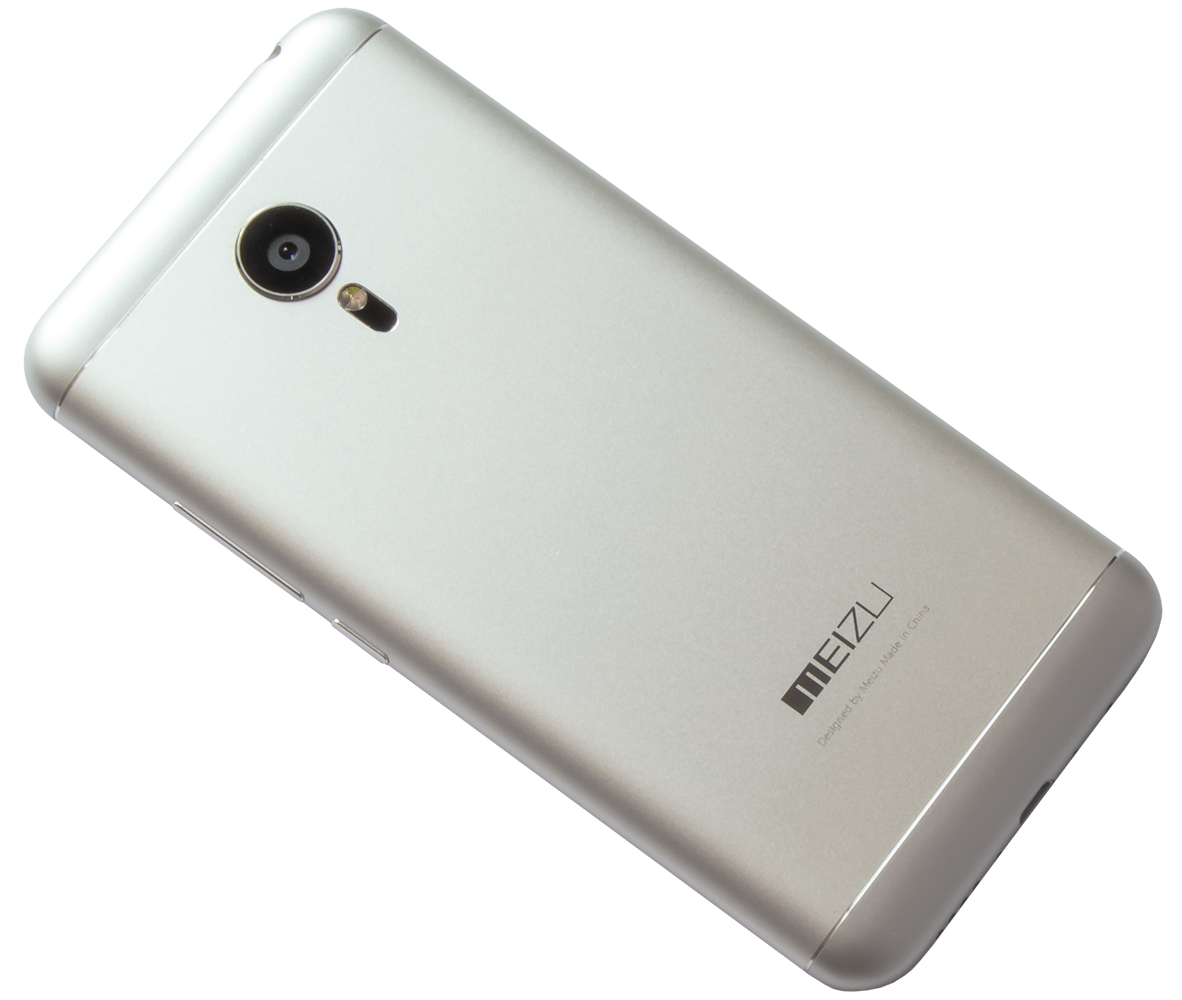
The most noticeable innovation is that the case is almost completely metal. In Meizu, this has been going on for quite a while, alternately using metal alloys now in the frame, then in the frame of their devices. But apparently, it is impossible to do without plastic. In view of this, the upper and lower faces are plastic. And it would seem surprising here? We have been observing the use of metal as the main material for the device case for a long time, we cannot ignore the fact that in 2015 this decision already applies to “budgets”.

However, Meizu managed to stand out from the gray mass of such solutions. Meizu takes about 30 days to get a finished 21-gram aluminum case from a 250-gram T6063 metal bar. The manufacturing process includes about 70 steps: rough machining, nano-casting, precision machining, polishing, anodizing and diamond cutting. Estimated accuracy up to 0.01 mm (10 μm). At all stages of work with metal, four-axis CNC machines are used, eliminating the influence of the human factor and guaranteeing high efficiency. It takes more than 40 hours to polish and paint, as the body is anodized and polished not once, but repeating the process up to five times. When painting, special clamps are used, which participate in the work only twice, after which they are disposed of. This is done in order

The internal frame for the board is made of magnesium alloy with a thickness of only 0.45 millimeters.

Given such labor costs, it is not surprising that a lot of attention was paid to the production of the smartphone at the presentation, and on the official website a whole section is devoted to this. This approach definitely deserves praise. The smartphone case has become one of the distinguishing features of the gadget. There are no complaints about the build quality - it does not creak, it does not play, it does not squeeze, it has no cracks, and the materials used can be described as excellent without embarrassment. I doubt that someone will remain unhappy.

The plastic itself used in the smartphone is not easy, but it is a special and durable polyphenylene sulfide (Polyphenylene Sulfide), which not only withstands loads, but easily withstands high temperatures, without affecting the quality of signal transmission. Separates the plastic inserts from above and below two fairly deep grooves treated with a diamond cutter, painted with a special varnish that are felt by the fingers. The decision is ambiguous, as over time dust and small pieces of clothing with other possible dirt get clogged up in such places. However, all this is easily cleaned with a soft cloth.

The side faces smoothly pass to the front panel. A thin polished frame separates the display unit from the back cover, due to which it pleasantly reflects the light, acquiring a soft silver color. Small plastic inserts also share it to improve the quality of network signal reception.

The front side is protected by third-generation Corning Gorilla Glass tempered glass. It is obvious that during testing the device did not lose its presentation. I think that with a vigilant and accurate attitude to the smartphone and throughout the year, the front panel will not get flaws. There is an oleophobic coating, but fingerprints remain, they are noticeable, and most importantly, they are erased with some difficulty, and the finger does not always slide smoothly.

A detailed examination of the gadget catches the eye of a mechanical button, combined with an fingerprint sensor, located under the display. The new key is called mTouch 2.0, and its first revision could be seen in the Mx4 Pro smartphone. The button is flat, slightly recessed into the case, made in the form of a rectangle with rounded corners.
The key performs the following functions: exit to the home screen with a single press, when touched - the function of returning back, with a long (about a second and a half) hold - locks the screen. According to official sources, the scanner works very quickly, up to 0.48 seconds. Now you can collect more information about the user's fingerprints, as the scanner resolution has increased by 81%. And this increases the accuracy of recognition from different angles. The key resource by the way is close to 300,000 keystrokes without unpleasant consequences. Also, a fixed layer of waterproof silicone gel was added under the module, which prevents water from entering and the formation of erosion inside. Is this so, only the operating time will show. At the moment, the key recognizes even quickly,
mTouch 2.0 builds on TrusTonic's Trusted Execution Environment (TEE). The main trick is that even if the device has root privileges, no application will be able to access the secure TEE area until it receives a review and signature of Meizu officials.

By the way, we will not see on the sides, familiar on other devices, buttons “recent applications” and “back”. However, they are not needed here, everything is tied to gestures and a central key.
In the center above the display is a small speaker. Its location is anatomically convenient, with a high probability of "looking for his ear" will not have to. To the right is a block with a proximity sensor and lighting. And even further the peephole of the front camera. To the left of the speaker is an event indicator. He hides under the glass and does not show himself in any working condition. Flashes smoothly in white - moonlight. The LED is quite bright, and you can see it at any angle during the glow. There are no complaints about the sensors in my test apparatus (many colleagues from other information platforms had such complaints ... maybe the programmers have already fixed these problems).

Behind, closer to the bottom there is a logo and a small inscription that informs that the design was developed in China by Meizu.

But above, there is only a double flash module (cold and warm glow), combined with laser autofocus and a large camera module protruding slightly above the surface. Around the latter there is a metal edging.
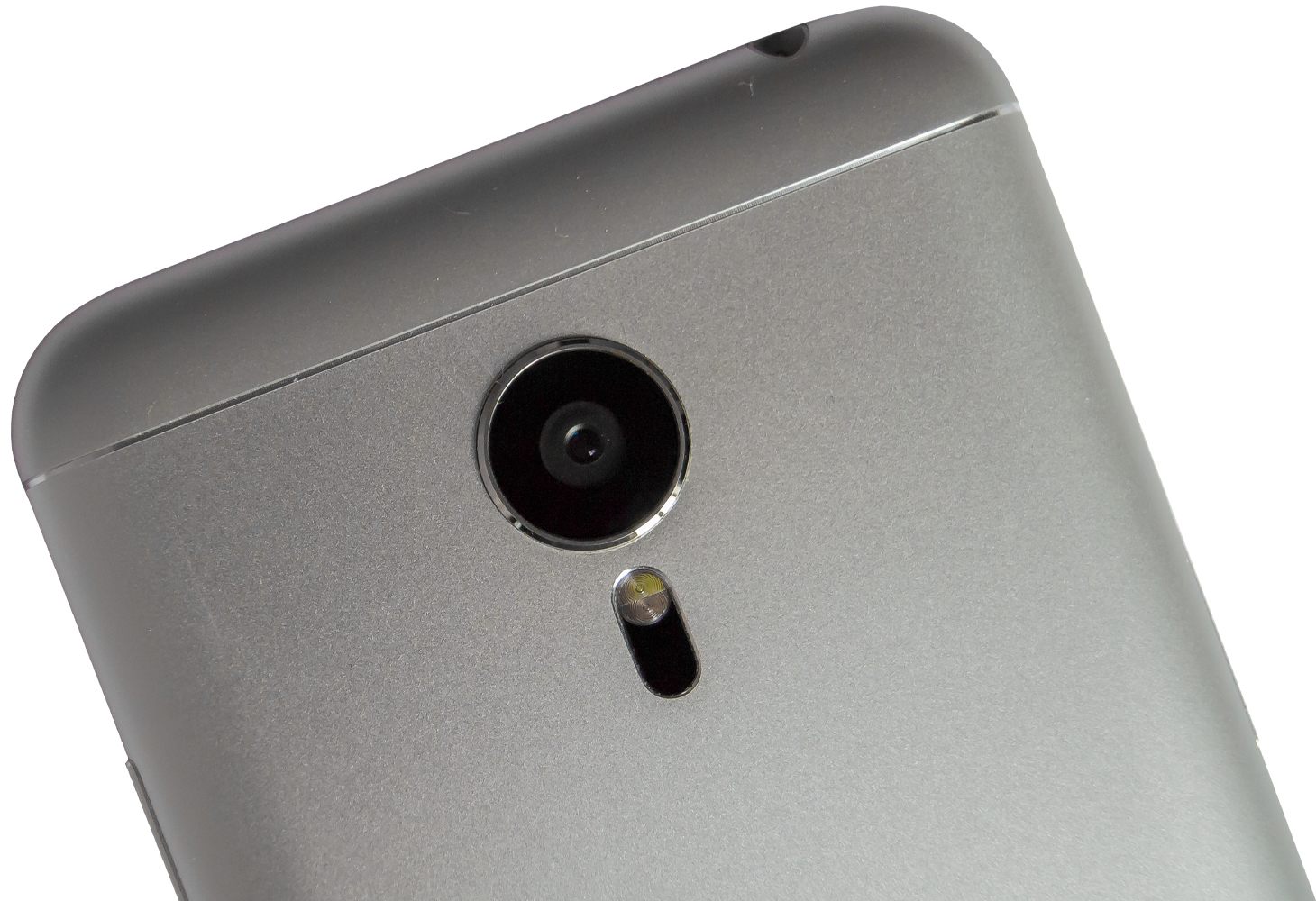
Bottom left is the perforated strip under which the speaker is hidden, in the center of the Micro - USB connector and then the microphone.

From above, an AUX connector and an additional microphone found their place, apparently, for noise reduction.
On the right side of the "rocker" volume control and the on / off key. Buttons, like the case, are also metal. There is no play, they are pressed with a characteristic click that is pleasant to the ear and without unnecessary effort. The location of the key block is anatomically very convenient.

On the left, besides the implied SIM tray, there is nothing more. The phone is “dual SIM”, two SIM - nanoSIM cards are placed in the tray.
As a result, we can say that the idea of the flagship corps is the first violin in the positioning of the model, it is clearly implemented successfully.
Meizu Mx5 is equipped with a Super AMOLED display with a diagonal of 5.5 inches and a resolution of 1920 x 1080 pixels. The physical size of the matrix is 68 x 121 mm. There is anti-reflective coating. The pixel density is 400 ppi. The manufacturer of the matrix is Samsung. Does it make sense to say that the picture on the display is clear? It is not possible to consider individual points even if you look very closely. Multi-touch supports up to ten simultaneous touches.

As a matter of fact, for the first time in recent years, the company has moved away from installing high-quality IPS matrixes, which have already become famous for their excellent and juicy picture. For me it was some surprise. On the manufacturer’s side, the choice of the development of Samsung and its brainchild Super AMOLED is explained by the following reasons: with a matrix thickness of 1.3 mm, which is 32% thinner than the screen of the previous generation model (Mx4), the full color gamut is observed with the maximum possible viewing angles. The combination of reduced power consumption (each pixel is highlighted separately) with an almost limit level of contrast (10,000: 1) for the human eye, coupled with a deep black color and rich colors are a good choice for a smartphone ...
Such statements, in the first place, can be considered as advertising, but you can’t deceive the user, the ideal is only on the way to us ... In the case of Super AMOLED technology, pentyle is the fly in the ointment. The disadvantages include a low maximum brightness of 350 nits, although initially the presentation talked about 500 nits. A similar value is 1.5-2 times lower than that of high-quality IPS matrices. The talk of Super AMOLED is still a dirty white color due to an unequal number of color subpixels, namely the green color exceeds the others, the noticeable color shift when the smartphone is tilted and the overly juicy color rendition also have their negative influence factor. And if you can still try to fix the latter programmatically, using the MiraVision technology, with which saturation, sharpness,

Is it worth arguing that the screen of the Meizu Mx5 failed? Of course not. In principle, there is enough brightness on a sunny day, in the sun the smartphone behaves very well (anti-glare coating affects). It is comfortable to use the smartphone in the dark - screens with AMOLED on board have always been famous for this (in addition, the Meizu Mx5 also used its own “ultra-dimming” technology, thanks to which the brightness drops down to 1.4 nits). In principle, you can get used to the displayed color range if you do not directly compare it with devices whose matrices are built in a different type. And the reduced power consumption really plays an important role in the modern race of smartphones during operation and maintaining image quality. In addition, Samsung, Nokia and many other companies have long been using displays in their devices, made using AMOLED technology. Many consumers believe that such solutions are completely ideal. From my humble point of view, it takes time to get used to and adapt the eyes to this display.
The symbiosis of MediaTek and Meizu is not the first time. Last year’s Mx4 was the top MediaTek chipset. It is likely that such cooperation satisfied Meizu and users, so the choice of the platform manufacturer was predetermined. Meizu Mx5 was among the first to receive the most productive SoC among those proposed among the MTK line, namely the 64-bit MediaTek Helio X10 in the turbocharged version - the working name MT6795T. It includes 8 Cortex-A53 cores manufactured by 28 nm process technology operating at a frequency of up to 2.2 GHz. The PowerVR G6200 chip with an operating frequency of up to 700 MHz is responsible for the graphics. Three gigabytes of LPDDR3 RAM at a frequency of up to 933 MHz complete the picture. (4 GB, probably we'll see in Mx 5 Pro) ... In general, I would like to know what needs to be done to fill the entire volume. What do you think about this? Will there be times when already in smartphones will not be enough of this amount of RAM? However, while in any case, more than half of the total volume is stably accessible to the user.
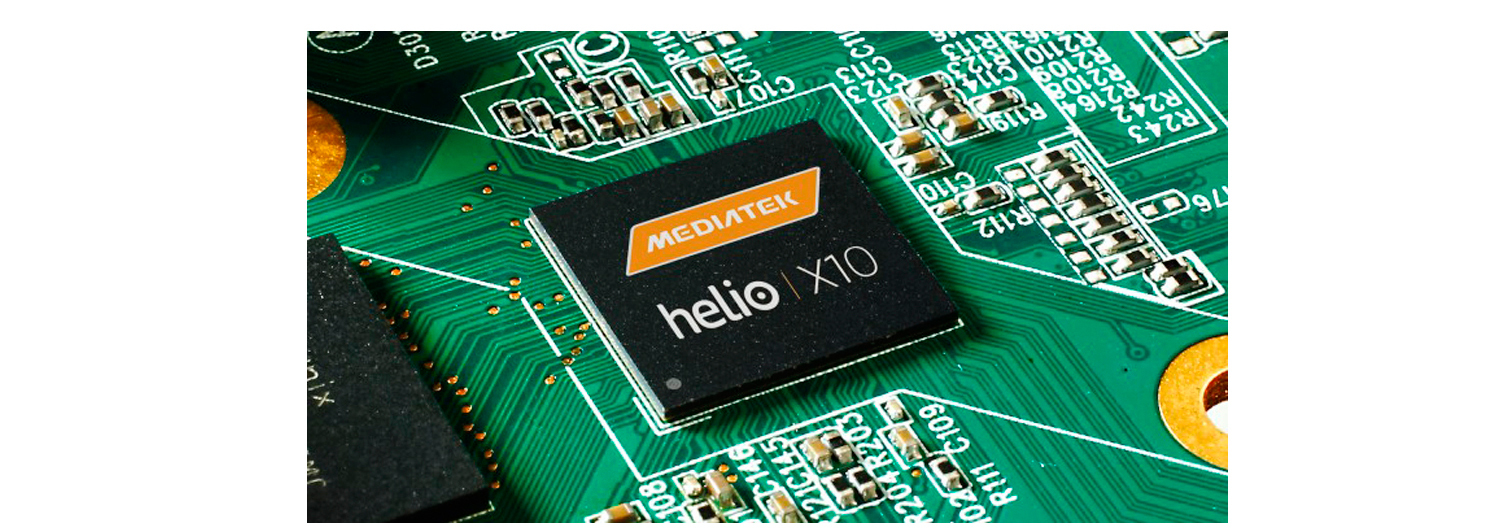
The manufacturer claims that the “filling” of the Mx5 is 17% faster than the Mx4. Check with such accuracy, we are unlikely to succeed. Let's try to evaluate the test results in various popular benchmarks. The resolution of the FullHD smartphone should have a beneficial effect on performance.


The final figures are clearly pleasing and are at a fairly high level compared to other gadgets in this segment, while the smartphone is practically not heated under load. Throttling is almost absent, which means that in the game process, fps will not sag due to heating. Perhaps this result is affected by the presence of MediaTek CorePilot 2.0 technology. Recalling its first version, the latest release took a significant step forward in the advancement of a performance monitoring system with reduced power consumption.

And what in real life? The interface works very smoothly, does not fail and does not lag. All applications run quickly, switching between them also does not cause complaints. There are simply no performance problems in games. I could not find more than one game that would cause a smartphone’s difficulty in the game process, reflected in FPS drawdowns or problems with graphic textures, for example. At the same time, the smartphone pulls all the toys at maximum settings. Given the applied display resolution, we can confidently assume that the performance of today's hero of the review will be enough with a margin for all modern tasks and not for one year. At the time of this writing, Meizu Mx5’s power is even excessive for them; for complete “happiness”, only 4 gigabytes of RAM is not enough.

In the end, in this section I would like to note that in the case of MX5, not only the ability to choose the operating modes of the hardware platform was added, but also unlike many other smartphones, the “chip” functions normally and brings real benefits. And just a few modes are available, an energy-saving mode in which performance is not enough to play cool toys, but it will quite pull most of the difficult tasks, whether it be a browser, social networks or something like that. At the same time, maintaining a smooth interface and speed in applications that do not require large resources. A balanced regime for many people will be the most optimal. For most everyday simple tasks, it’s enough with your head, and you can already play toys at medium settings. And the energy consumption is still not significant. Well,
Meizu Mx5 is running the Google Android operating system version 5.1 (Lollipop). However, the standard interface was almost completely redesigned by Meizu programmers, after which in fact we have a completely new interface with its own features and chips. The proprietary shell is called Flyme. In our case, version 4.5. Compared to the previous version, not many features have been introduced, but in the future I will note the main features of the launcher, if you have not encountered it before.
Generalized - animation, icons, general design, most of the settings remained the same as before. Sadly, we will probably see a radical update to the interface only after the debut of Meizu Mx5 Pro. And maybe even later.
The OTA update is implemented here, so you can safely wait. At the very beginning of testing, the device even received some kind of small update. In general, Meizu have earned a good reputation by not abandoning smartphones in software support after the release. And the speed of release of these updates is not the smallest, if we are not talking about fixing some allowed bugs - in this case, everything happens almost instantly.
In order to familiarize myself with the interface, I will give a set of screenshots with comments.

The interface is implemented on the basis of the removal of application icons on desktops. The application menu is missing here. The notification shutter goes down the swipe from top to bottom from any height, it contains the standard date, time, some basic quick settings and notifications. Scrolling up and down opens the multitasking menu in the form of a horizontal list.

If you swipe the icon up in it, the selected application will be closed; if you swipe any program down, the entire menu will be cleared. If you hold the selected program, it will be blocked from cleaning and will remain “in memory” (a small lock will appear above the program), while other programs will not be deleted from the list.
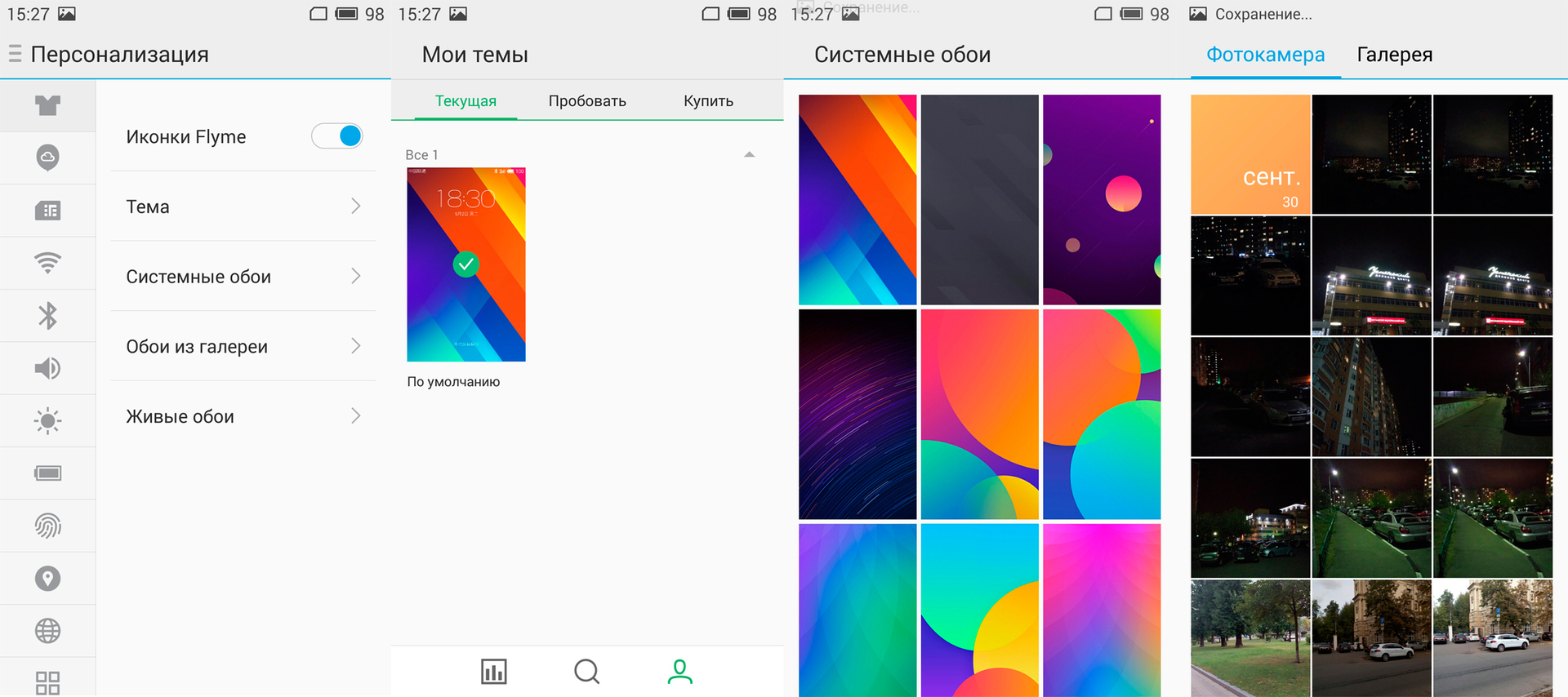
Not bad in the system is the ability to personalize for yourself, you can change not only the classic background images, but also themes that replace many design elements. Including, of course, icons.

A gesture system is developed, their settings are quite wide. They are especially useful when the display is off. So, for example, on a double tap, the smartphone screen wakes up. Scrolling from bottom to top unlocks you - you get used to this function very much over time, since you don’t need to reach for the lock key. Based on personal experience, I can say that for my own convenience I had to implement this function using software and cores on my smartphone from another manufacturer. It is possible to attach certain applications to drawn letters on the display.
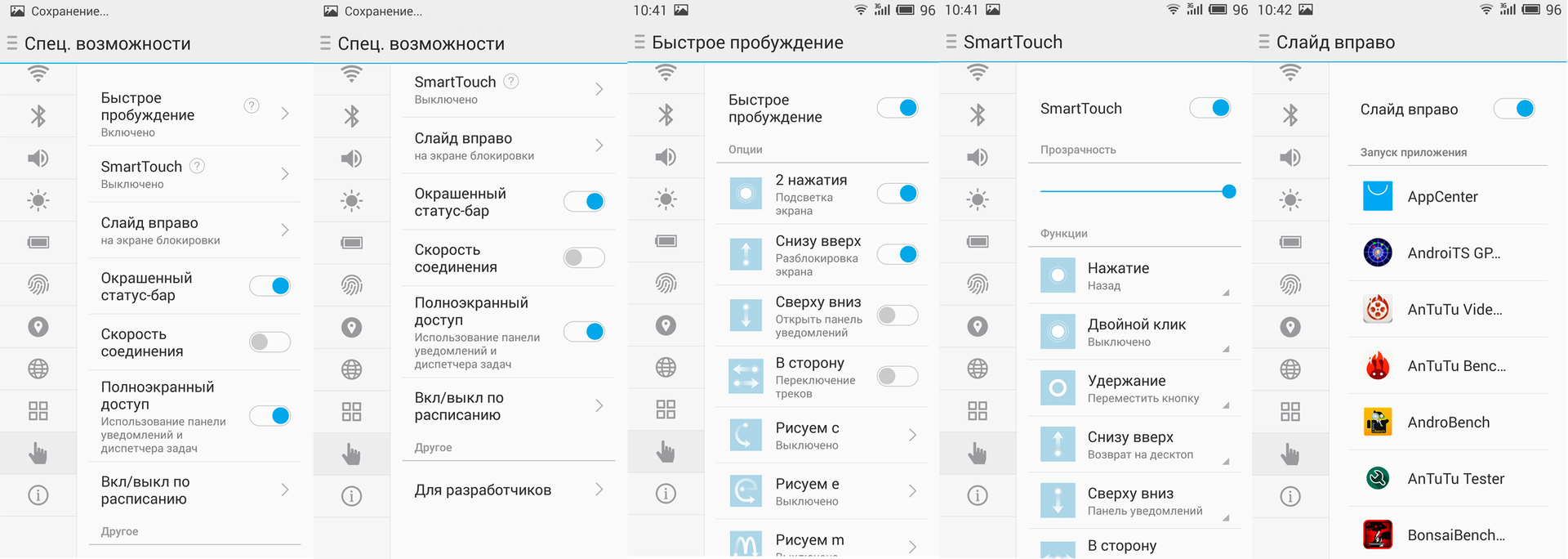
Fans of minimalism will also be pleased ... In Mx5, there are not so many non-stock Android software preinstalled. Basically, only what is needed: an alarm clock, a convenient file manager, a gallery with good potential in editing mode, a notepad for notes, a security center that cleans the system of unnecessary ones and serves as a distribution of permissions to programs. There is also a calculator-converter working in a separate window, a video player that reproduces most formats without problems, a music player and a proprietary drawing machine with a full set of tools, familiar to us from past Meizu smartphones. There is also a proprietary software package from Google, though not complete. But, for example, Play Music, Play Press, etc. no programs. There are cards with a convenient email client and a theme store. You can use the predefined voice recorder to record sound. FM radio, unfortunately, no.

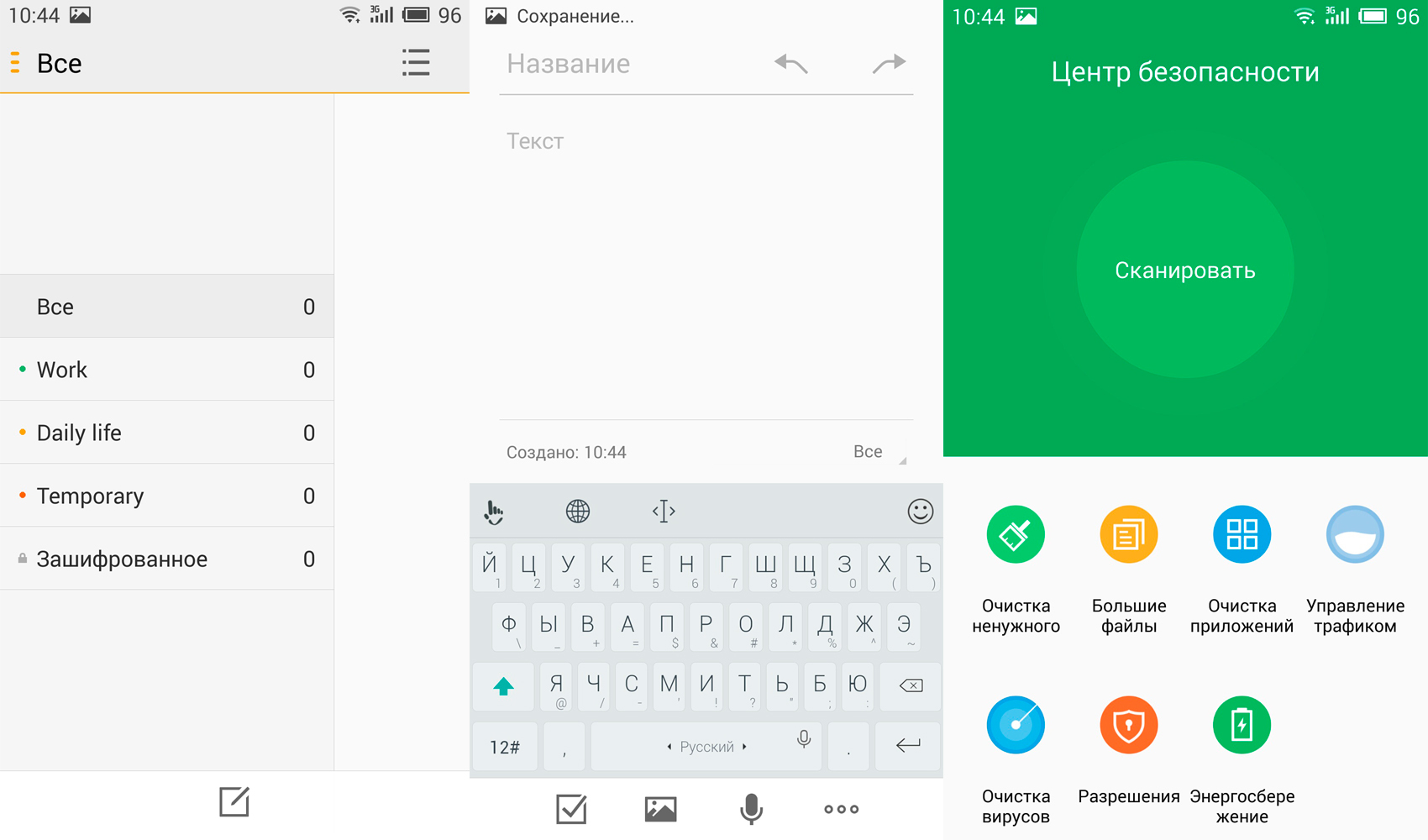
The general settings of the smartphone look like this:

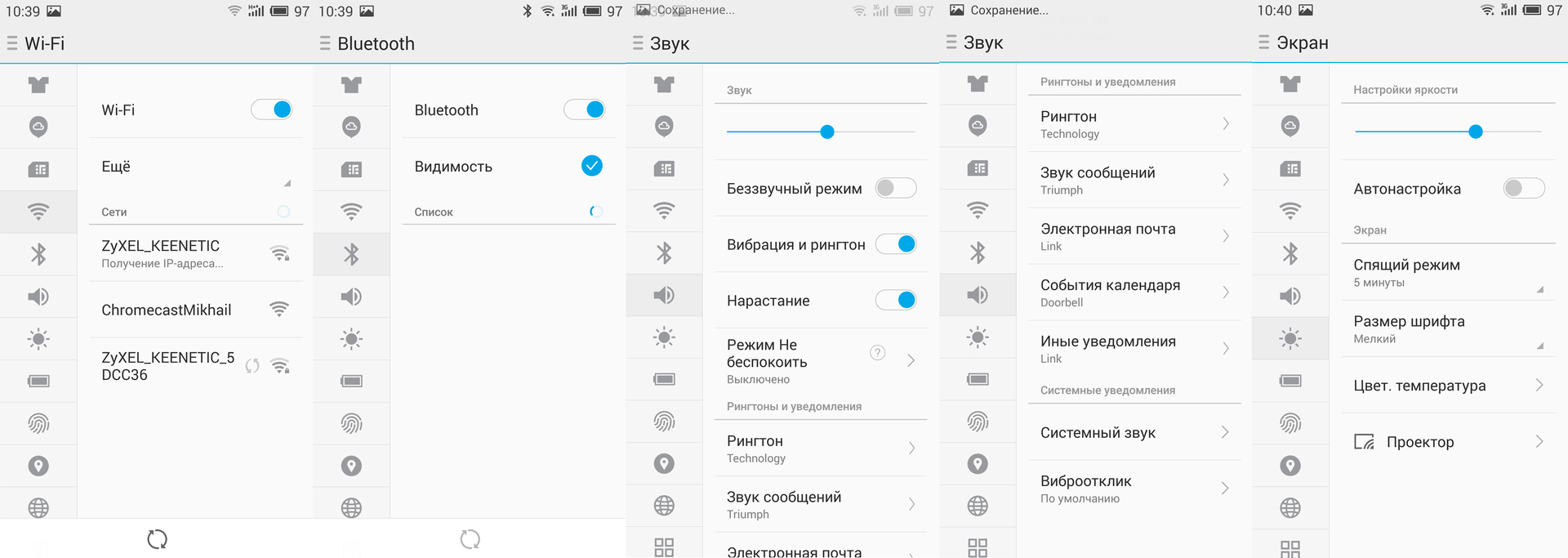
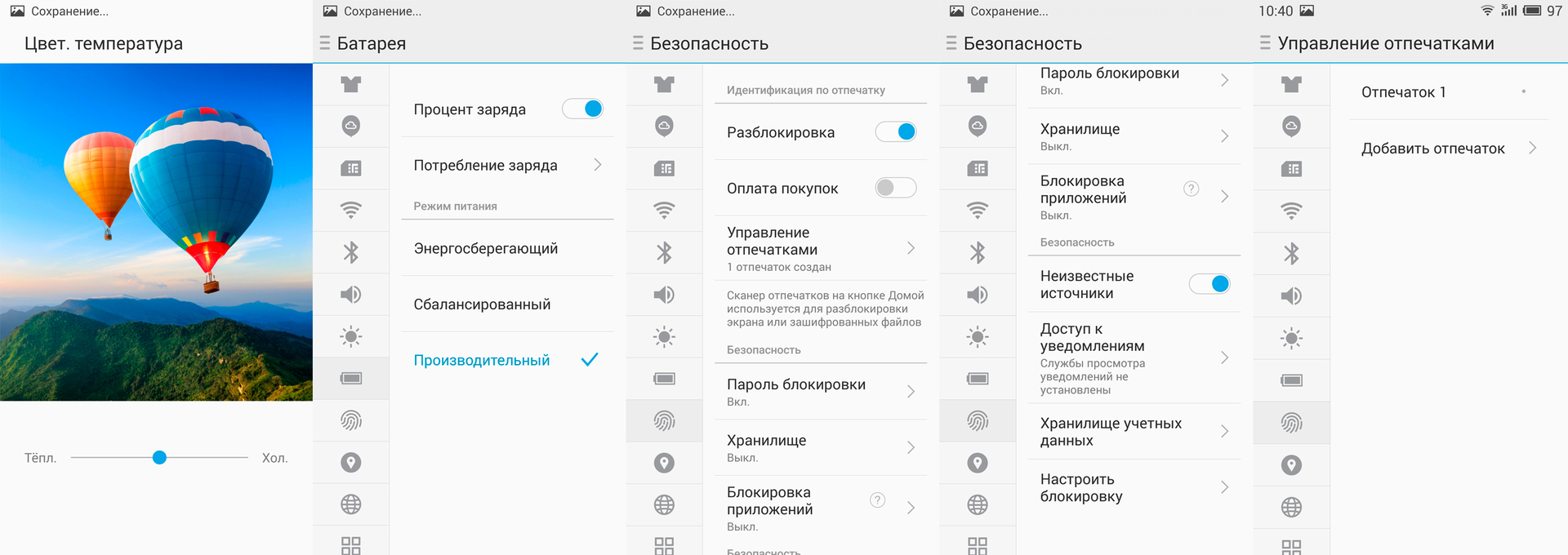

Using AnTuTu Video Tester, I checked the exact number of supported video formats. The results are impressive.
The smartphone does not have problems playing video from the network.

In general, the Meizu shell looks pretty. It works smoothly and without failures, makes a good impression. The first time is a bit unusual - it takes time to get used to it, but then you start to get into the system and understand that, in principle, everything is done for the person and his comfort - it will be difficult to find something extra. Over the entire testing period, not a single failure occurred. There were no problems with localization. But there are some bugs from those noticed: when using any “custom” keyboard (Fleksy, Swift and others), it is impossible to move the carriage between words or characters in a message, that is, to correct a mistake in a word or sentence, it must be deleted and reprinted again. When using a standard keyboard or Google Keyboard, this is not the case. It should also be noted that starting with MX5, it is impossible to “roll” a fully localized firmware on the Chinese version of the smartphone - this must be taken into account when buying. However, it’s quite realistic to partially introduce the Russian language with Google services into such a smartphone. But according to the feedback of users, problems can arise with them in the future and it is not always possible to count on stable operation. As a separate plus, I note that in the international version of Meizu Mx5 all Chinese applications are cut out of software.
Let's talk in more detail about the musical part of the smartphone. The pre-installed music player is convenient, with headphones connected it provides access to the equalizer settings with presets and the sound enhancement function. Finally, for obvious reasons, online services for China were cut from the player. This is also the prerogative of official suppliers in the Russian Federation. Outwardly, he remained quite handsome. The only nuance, now the player has forgotten how to load covers and text for music albums from the network. As for the sound, there are no subjective complaints about the hardware of the smartphone: the smartphone plays loudly (this is especially noticeable in comparison with MX4), the sound is clear, detailed, there are no noticeable problems with any frequency range. Bass smartphone is nice. However, with the Mx 4 Pro, which somehow was on my test, I won’t be able to compete on an equal footing, nevertheless, the musical potential there is noticeably greater. Evaluation of musical capabilities was carried out with headphones Sony MDR - 1R, and the tracks were in FLAC format. I was also pleased that the player can recognize and play even music in the .ALAC format. Honestly - did not expect.


MediaTek does not disclose the audio chip marking on the MT6795, but the sound is unlikely to leave the mobile music lover indifferent. I propose to see what the test in RMAA showed us. Before the test, the maximum volume of the device signal was about - 6.0 dB.
There were no complaints about the operation of microphones during the entire testing period. As with the conversational dynamics. The ringing speaker is not characterized by high quality playback, but in principle it copes with its task normally. Stock volume is present.
Meizu Mx5 supports two nanoSIM slots. Both SIM cards can work in 3G / 4G networks and are installed in one tray. The smartphone generally supports the following frequencies: GSM / GPRS / EDGE (900/1800 MHz), WCDMA / HSPA + (900/2100 MHz) and LTE (1800/2100 MHz). In the presence of Wi-Fi (ac, b / g / n), Bluetooth 4.1 LE and (A) GPS / GLONASS. NFC and the possibility of wireless charging, as I understand it, are absent. All connections are stable and fast. In the conditions of Moscow and Moscow Region, the signal level of the network is high. Communication is not lost, the smartphone stably holds the network.
Many journalists complained that not all operators support the LTE network. And there are problems with the reception in general. However, I did not manage to encounter such problems with the operator Megafon, but it is worth considering this.
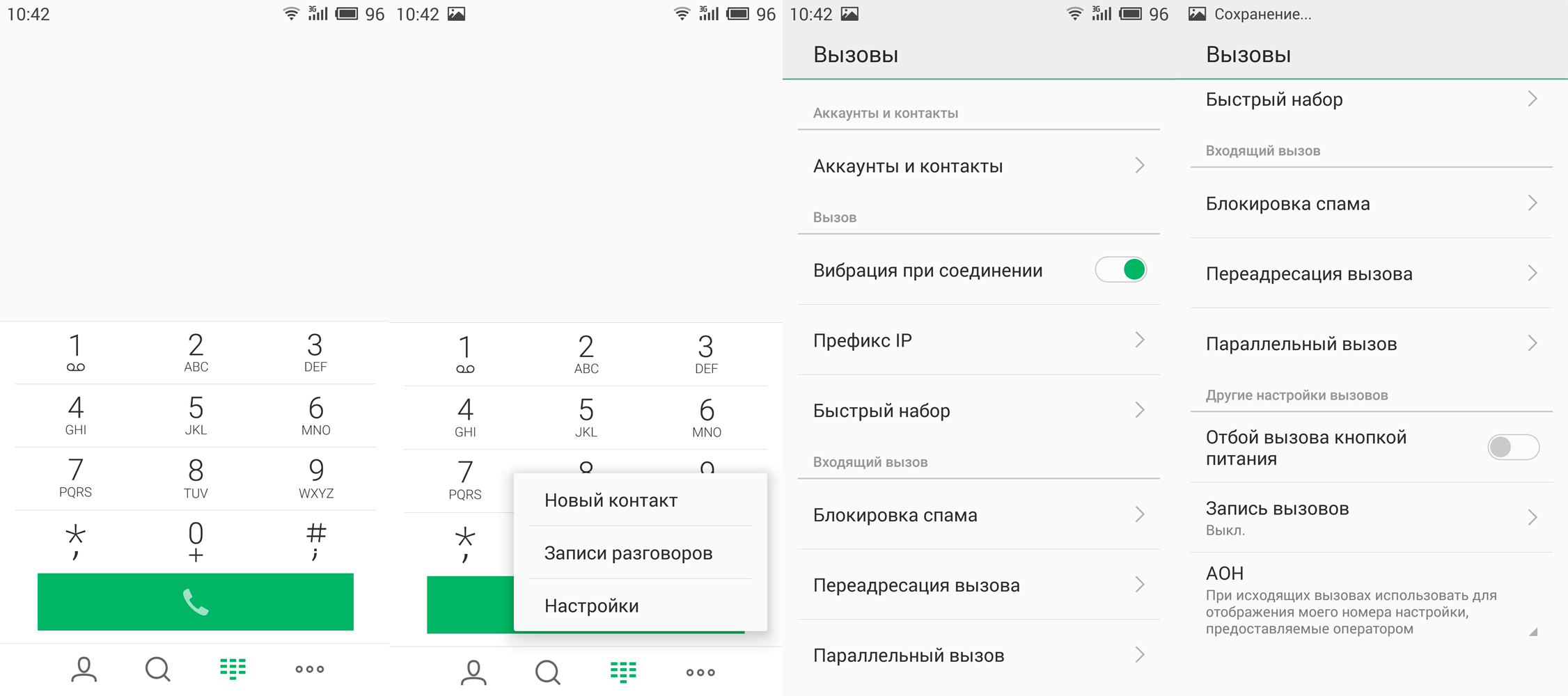
The phone and SMS messaging application has been redesigned and is relatively unlike the standard one. However, they are quite convenient and intuitive. Regularly, you can record conversations.

Geo-positioning works well. GPS cold start takes about a minute, and hot almost instantly, after which the positioning works stably and without failures.

The positioning accuracy is excellent, tracking is smooth when moving. Exaggerating the cost of the smartphone, Mx5 is perfect for the role of a device for communication, providing a decent level of communication quality and stable operation of the navigator.
In the case of the Mx5, you can choose from three options for the built-in flash memory on board: 16, 32 and 64 GB. While on sale versions of 16 and 32 gigabytes are available. It will not be surprising if the 64 gigabyte version does not come out retail, as it was with some other models of the company. Of these volumes, about 13 and 25 GB, respectively, are available for the user's needs. It is a lot or a little - everyone decides for himself. However, it is worth considering that it is not possible to use memory cards here, this is simply not implemented in a smartphone.
Will have to be satisfied only with the volume provided. And in case of a lack of memory, use cloud solutions or try to solve the problem using an external USB-stick and a USB-OTG cable.
I already mentioned the presence of a simple and intuitive file manager in the previous section on software. I propose to consider it in more detail in the following screenshots.

A test was also conducted in the AndroBench application to assess the speed of the memory.

Data is exchanged using a USB 2.0 connector.
The smartphone is equipped with a built-in battery capacity of 3 150 mAh. This is an average indicator for flagship devices in 2015. Given the energy reserve, taking into account not the most economical stuffing, coupled with a FullHD display, the resolution will be enough for functioning from morning to evening in the optimal operating mode.
In everyday use, my smartphone was enough for a full day. The usage scenario was approximately the following: about 15-20 minutes of conversations per day, 2 hours of work with an active Internet connection using a SIM card - checking mail, alternately surfing social networks, working in an Internet browser, then a permanent Wi-Fi connection and from time to time browsing the Internet through the stock browser, meeting in the social. networks, a couple of hours of listening to music through headphones and two hours of watching content on YouTube. All this was accompanied by a brightness level set by the automation, according to sensations, most of the time the brightness was set in the region of 35-50%. I do not exclude that in a more gentle mode, the smartphone can work more, especially when the power saving mode and lower SoC costs are turned on. And also less in constant load mode, for example, in a heavy toy. In this case, the smartphone is unlikely to last more than 4.5 - 5 hours.
In preparation for the article, the smartphone went through a full cycle of autonomy tests in AnTuTu Tester and Geekbench 3.

The test results are not record-breaking, but it is difficult to call such values low.
The complete power adapter has the following characteristics: Input - 100-240V ~ 50-60 Hz, 0.3 A; Output - 5V ~ 2A, Model: UP0520E.
The device charges quite quickly, about 2 hours will take 100% charge of the gadget. The manufacturer also promises that up to 25% of the smartphone will be charged in just 10 minutes and up to 60% in 40, thanks to proprietary mCharge technology.

The bottom line is, Meizu Mx5 can not be called a leader in battery life. But scolding for a critically small supply of energy also does not work. With a reasonable energy consumption, the battery reserve is enough. And an increase in capacity would lead in the future to an increase in weight and size characteristics, and indeed the manufacturer would want to add a 2K screen, if only an average user needs it now? It seems to me that no. It would be interesting to hear your opinions on this matter.
Meizu Mx5 is equipped with two cameras, the main module contains a 20.7-megapixel Sony IMX220 sensor with an area of 1 / 2.3 ”with a pixel size of 1.2 microns, 6-element optics with aperture f / 2.2, dual LED flash (warm and cold shades), as well as laser autofocus and protective glass Gorilla Glass 3. A similar module was in the company's previous device - Mx4. But some software algorithms were changed: the new shutter release logic, color settings, white balance and sharpness are used. In the case of the front camera, everything is much more modest and more hidden, it is only known that it has a resolution of 5.0 megapixels and an f / 2.0 aperture.

The camera interface is simple, convenient and intuitive. Most settings are familiar to the look. The appearance of the application is your own. In principle, the design of the "camera" is identical to other relevant smartphones from the manufacturer's line. All that is missing is the ability to shoot in .RAW ... With such a camera, this solution would not be out of place.
The quality and clarity of the main camera images are pleasing to the eye. White balance is selected almost unmistakably, the colors are nice, the picture is sharp. Detailing at close ranges pleases, however, when shooting with a focus on “infinity”, the frame is less clear. Noises in good lighting are hardly noticeable, which cannot be said under the worst conditions. But despite the falling clarity and noise, the picture still remains "very nothing." Autofocus during work does not scour and works really extremely fast. But there is one flaw, and I really want to believe that it is software - which means it will be fixed soon. When trying to focus on a small subject in macro mode, it is very rare for a smartphone to be able to focus on a specified subject. Sometimes it comes to the fact that out of 10 attempts, only one is successful.
The front camera produces generally good shots, but nothing more - still the sharpness is lame. For daily "self" is more suitable.

Video in good lighting turns out to be excellent, and in poor lighting it loses sharply in quality and sharpness. But autofocus behaves appropriately in both of these situations. Recording is supported both in 1080p from the main and front cameras, and additionally video is recorded in 4K at 30 fps from the main. A picture in this format satisfies with its quality, but not every editor will be able to open the video, and you won’t be able to upload it to YouTube, as it is written with the H265 video codec.
There is a slow motion mode, which is conducted in an unusual resolution of 1280 x 736 pixels at a speed of 100 frames per second. Sound is recorded in stereo. The quality is acceptable.
Obviously, Meizu Mx5 leaves a positive impression after testing. Despite the seemingly minor changes, the smartphone was technically re-equipped almost completely. But, nevertheless, the best definition of the new version of Meizu Mx5 is a deep restyling of the Mx4.
The first thing that attracts attention is the high quality of the materials used, the level of assembly of the body and fitting of parts, as well as a camera with potential and a margin in performance. Already these points justify the cost of a smartphone, which at the time of writing of the article according to official data in the retail of the Russian Federation varies from 28,000 for a 16 GB version and from 30,000 for a version with 32 gigabytes on board. There are no complaints about the interface, which works stably fast, pleasing with its optimization and the external component. The controversial points include the used Super AMOLED matrix with all its pros and cons. Separately pleased with such features as laser autofocus, a fingerprint scanner and some kind of sound potential of a smartphone. Frankly, for a week of testing, the smartphone has never disappointed me, and parting with him is very sad. Meizu did not lie, stating that the smartphone was created with a focus on the needs of users. When you take the gadget in your hands - it is felt from all points of view. It is indisputable that precisely thanks to the client-oriented approach, the company is growing so rapidly and inspires confidence among ordinary users. What do you think of the new product? Interestingly, would you buy such a smartphone?
Dear reader, we also remind you that you can buy Meizu Mx5 from the first official party in Russia on our website .
Less than a year ago after the successful launch of the Meizu Mx4 and its older sobart Meizu Mx4 Pro, June 30, 2015 was presented a new product - Meizu Mx5. This time the company focused on the needs and needs of users, and not just on the characteristics. The approach is correct, because today it is difficult to surprise someone with a fast processor or the amount of installed memory. But it is worth noting that the models of the Meizu MX line have never dropped into the segment of the average price, even in their homeland in China. In view of this, the smartphone fully lives up to consumer expectations, having in its arsenal an attractive feature set. And now, the smartphone is also officially delivered to the territory of the Russian Federation with all the advantages of legalized smartphones.

Before starting the Meizu Mx5 review, I suggest that you familiarize yourself with the list of technical specifications.
* Caution traffic
Main characteristics
• Case materials: metal, glass (front panel - Gorilla Glass 3);
• Display: SuperAMOLED, diagonal of 5.5 ”inches, resolution 1920 x 1080 pixels, 406 ppi;
• Processor: eight-core MediaTek MT6795T, 64-bit, Cortex A53 at a frequency of 2.2 GHz, built on the Helio X10 Turbo platform;
• Video chip: PowerVR G6200 MP4, operating at a frequency of 700 MHz;
• Operating system: Android 5.0.1, Flyme 4.5 *;
• RAM: 3 GB;
• Memory for data storage: 16/32/64 GB, no microSD slot;
• Interfaces: Wi-Fi (ac / a / b / g / n) Dual-Band, Bluetooth 4.1 (LE), GPS (A-GPS support), Glonass, microUSB 2.0 connector (MHL, USB-OTG), AUX;
• Network: GSM / EDGE, UMTS / HSDPA, LTE (TD / FDD-LTE), (Dual SIM support);
• Main camera: 20.7 MP, Sony IMX230 sensor, f / 2.2 aperture, laser autofocus, dual LED flash. Ability to shoot video in 720 / 1080p and 4K;
• Front camera: 5 MP without autofocus, OV5670 sensor, f / 2.0 aperture, Ability to shoot video in 720 / 1080p;
• Sensors: fingerprint scanner (brand name mTouch 2.0), accelerometer, light sensor, proximity sensor;
• Battery: 3150 mAh;
• Dimensions: 149.9 x 74.7 x 7.6 mm;
• Weight: 149 grams.
Packaging and delivery
Meizu MX5 comes in a new oversized package - 105 x 180 x 65 mm. The box is made of cardboard with a nice silky finish. Everything is very tightly fitted and getting to the contents is not an easy task.

What, in fact, is novelty? If you were previously familiar with Meizu products, then you will surely recall that all of the company's new products are packed in compact flat, square boxes. I’m not sure that the new solution can be called original and promising, rather intriguing. However, I note that in the supply for China, the smartphone comes without a box and is offered in the form of an improvised book with a cardboard cover. And the network charger is slightly different, sharpened for Chinese outlets.

There are at least inscriptions on the package - only the model name on top, the name of the manufacturer on the side and a neatly designed sticker on the bottom containing legal information about the product.
Inside, traditionally for the MX series, the smartphone lies in a kind of book combined with a brochure. The pages list the main advantages of the device, but for some reason in English ...




Under the “book” is a small paper folder with a company clip for removing the SIM tray and user documentation, which, incidentally, contains Russian in some places.


And here is the documentation itself:


In the depths, in a plastic bath, there is a small power adapter with an output current of two amperes and a classic USB cable version 2.0. And also a rather interesting plug in the place "under the headphones", which in the case of commercial deliveries are not equipped with the device. They can be purchased separately if desired. Officially presented two headsets - EP-21HD and EP-20S. They should be delivered in branded plastic boxes with a transparent front cover. All branded accessories are made in white colors.



There are no complaints about the quality of manufacturing accessories, as well as the box. The smartphone is presented pretentiously and, I must say, it is deserved. In the end, you can only complain about the lack of a headset.
Appearance and design features
Design Meizu Mx5 certainly resembles its predecessor Meizu Mx4, but is not a direct copy. It is made in the classic monoblock form factor for the “gadgets” of recent years with a touch screen on the front side. At the same time, the corners of the case are rounded, the sides are sloping, and the “face” of the smartphone can be inadvertently confused with the Samsung Galaxy S6. But, upon closer examination, the appearance of the model, of course, looks more self-sufficient. Only the branded touch circle on the front side disappeared, but more on that later ... The

dimensions of the smartphone are 149.9 x 74.7 x 7.6 mm, weight - 149 g. The indentations from the display on top are 18.5 millimeters, below - 19.5 mm, on the sides about 3 mm.

With such dimensions and five and a half inches of the display, it is safe to say that the Meizu Mx5 has a very light and compact body. Everything is by the standards of the flagship. The smartphone has narrow frames and small indentation, comfortably lies in the hand. The device does not look like a classic “shovel”, both in small and medium hands. It affects the convenient shape of the rear panel and properly selected dimensions. It feels tactile in flagship and looks expensive. I can’t also name the smartphone soiled. The materials used are not wholly susceptible to rapid abrasion or scratching. I would compare those with the materials used to make MacBooks of the Air or Pro series. Only unlike the latter, the smartphone has several colors, namely four: gold with a golden back panel, white with silver,

The most noticeable innovation is that the case is almost completely metal. In Meizu, this has been going on for quite a while, alternately using metal alloys now in the frame, then in the frame of their devices. But apparently, it is impossible to do without plastic. In view of this, the upper and lower faces are plastic. And it would seem surprising here? We have been observing the use of metal as the main material for the device case for a long time, we cannot ignore the fact that in 2015 this decision already applies to “budgets”.

However, Meizu managed to stand out from the gray mass of such solutions. Meizu takes about 30 days to get a finished 21-gram aluminum case from a 250-gram T6063 metal bar. The manufacturing process includes about 70 steps: rough machining, nano-casting, precision machining, polishing, anodizing and diamond cutting. Estimated accuracy up to 0.01 mm (10 μm). At all stages of work with metal, four-axis CNC machines are used, eliminating the influence of the human factor and guaranteeing high efficiency. It takes more than 40 hours to polish and paint, as the body is anodized and polished not once, but repeating the process up to five times. When painting, special clamps are used, which participate in the work only twice, after which they are disposed of. This is done in order

The internal frame for the board is made of magnesium alloy with a thickness of only 0.45 millimeters.

Given such labor costs, it is not surprising that a lot of attention was paid to the production of the smartphone at the presentation, and on the official website a whole section is devoted to this. This approach definitely deserves praise. The smartphone case has become one of the distinguishing features of the gadget. There are no complaints about the build quality - it does not creak, it does not play, it does not squeeze, it has no cracks, and the materials used can be described as excellent without embarrassment. I doubt that someone will remain unhappy.

The plastic itself used in the smartphone is not easy, but it is a special and durable polyphenylene sulfide (Polyphenylene Sulfide), which not only withstands loads, but easily withstands high temperatures, without affecting the quality of signal transmission. Separates the plastic inserts from above and below two fairly deep grooves treated with a diamond cutter, painted with a special varnish that are felt by the fingers. The decision is ambiguous, as over time dust and small pieces of clothing with other possible dirt get clogged up in such places. However, all this is easily cleaned with a soft cloth.

The side faces smoothly pass to the front panel. A thin polished frame separates the display unit from the back cover, due to which it pleasantly reflects the light, acquiring a soft silver color. Small plastic inserts also share it to improve the quality of network signal reception.

The front side is protected by third-generation Corning Gorilla Glass tempered glass. It is obvious that during testing the device did not lose its presentation. I think that with a vigilant and accurate attitude to the smartphone and throughout the year, the front panel will not get flaws. There is an oleophobic coating, but fingerprints remain, they are noticeable, and most importantly, they are erased with some difficulty, and the finger does not always slide smoothly.

A detailed examination of the gadget catches the eye of a mechanical button, combined with an fingerprint sensor, located under the display. The new key is called mTouch 2.0, and its first revision could be seen in the Mx4 Pro smartphone. The button is flat, slightly recessed into the case, made in the form of a rectangle with rounded corners.
The key performs the following functions: exit to the home screen with a single press, when touched - the function of returning back, with a long (about a second and a half) hold - locks the screen. According to official sources, the scanner works very quickly, up to 0.48 seconds. Now you can collect more information about the user's fingerprints, as the scanner resolution has increased by 81%. And this increases the accuracy of recognition from different angles. The key resource by the way is close to 300,000 keystrokes without unpleasant consequences. Also, a fixed layer of waterproof silicone gel was added under the module, which prevents water from entering and the formation of erosion inside. Is this so, only the operating time will show. At the moment, the key recognizes even quickly,
mTouch 2.0 builds on TrusTonic's Trusted Execution Environment (TEE). The main trick is that even if the device has root privileges, no application will be able to access the secure TEE area until it receives a review and signature of Meizu officials.

By the way, we will not see on the sides, familiar on other devices, buttons “recent applications” and “back”. However, they are not needed here, everything is tied to gestures and a central key.
In the center above the display is a small speaker. Its location is anatomically convenient, with a high probability of "looking for his ear" will not have to. To the right is a block with a proximity sensor and lighting. And even further the peephole of the front camera. To the left of the speaker is an event indicator. He hides under the glass and does not show himself in any working condition. Flashes smoothly in white - moonlight. The LED is quite bright, and you can see it at any angle during the glow. There are no complaints about the sensors in my test apparatus (many colleagues from other information platforms had such complaints ... maybe the programmers have already fixed these problems).

Behind, closer to the bottom there is a logo and a small inscription that informs that the design was developed in China by Meizu.

But above, there is only a double flash module (cold and warm glow), combined with laser autofocus and a large camera module protruding slightly above the surface. Around the latter there is a metal edging.

Bottom left is the perforated strip under which the speaker is hidden, in the center of the Micro - USB connector and then the microphone.

From above, an AUX connector and an additional microphone found their place, apparently, for noise reduction.
On the right side of the "rocker" volume control and the on / off key. Buttons, like the case, are also metal. There is no play, they are pressed with a characteristic click that is pleasant to the ear and without unnecessary effort. The location of the key block is anatomically very convenient.

On the left, besides the implied SIM tray, there is nothing more. The phone is “dual SIM”, two SIM - nanoSIM cards are placed in the tray.
As a result, we can say that the idea of the flagship corps is the first violin in the positioning of the model, it is clearly implemented successfully.
Display
Meizu Mx5 is equipped with a Super AMOLED display with a diagonal of 5.5 inches and a resolution of 1920 x 1080 pixels. The physical size of the matrix is 68 x 121 mm. There is anti-reflective coating. The pixel density is 400 ppi. The manufacturer of the matrix is Samsung. Does it make sense to say that the picture on the display is clear? It is not possible to consider individual points even if you look very closely. Multi-touch supports up to ten simultaneous touches.

As a matter of fact, for the first time in recent years, the company has moved away from installing high-quality IPS matrixes, which have already become famous for their excellent and juicy picture. For me it was some surprise. On the manufacturer’s side, the choice of the development of Samsung and its brainchild Super AMOLED is explained by the following reasons: with a matrix thickness of 1.3 mm, which is 32% thinner than the screen of the previous generation model (Mx4), the full color gamut is observed with the maximum possible viewing angles. The combination of reduced power consumption (each pixel is highlighted separately) with an almost limit level of contrast (10,000: 1) for the human eye, coupled with a deep black color and rich colors are a good choice for a smartphone ...
Smartphone screenshots











Such statements, in the first place, can be considered as advertising, but you can’t deceive the user, the ideal is only on the way to us ... In the case of Super AMOLED technology, pentyle is the fly in the ointment. The disadvantages include a low maximum brightness of 350 nits, although initially the presentation talked about 500 nits. A similar value is 1.5-2 times lower than that of high-quality IPS matrices. The talk of Super AMOLED is still a dirty white color due to an unequal number of color subpixels, namely the green color exceeds the others, the noticeable color shift when the smartphone is tilted and the overly juicy color rendition also have their negative influence factor. And if you can still try to fix the latter programmatically, using the MiraVision technology, with which saturation, sharpness,

Is it worth arguing that the screen of the Meizu Mx5 failed? Of course not. In principle, there is enough brightness on a sunny day, in the sun the smartphone behaves very well (anti-glare coating affects). It is comfortable to use the smartphone in the dark - screens with AMOLED on board have always been famous for this (in addition, the Meizu Mx5 also used its own “ultra-dimming” technology, thanks to which the brightness drops down to 1.4 nits). In principle, you can get used to the displayed color range if you do not directly compare it with devices whose matrices are built in a different type. And the reduced power consumption really plays an important role in the modern race of smartphones during operation and maintaining image quality. In addition, Samsung, Nokia and many other companies have long been using displays in their devices, made using AMOLED technology. Many consumers believe that such solutions are completely ideal. From my humble point of view, it takes time to get used to and adapt the eyes to this display.
Performance and hardware
The symbiosis of MediaTek and Meizu is not the first time. Last year’s Mx4 was the top MediaTek chipset. It is likely that such cooperation satisfied Meizu and users, so the choice of the platform manufacturer was predetermined. Meizu Mx5 was among the first to receive the most productive SoC among those proposed among the MTK line, namely the 64-bit MediaTek Helio X10 in the turbocharged version - the working name MT6795T. It includes 8 Cortex-A53 cores manufactured by 28 nm process technology operating at a frequency of up to 2.2 GHz. The PowerVR G6200 chip with an operating frequency of up to 700 MHz is responsible for the graphics. Three gigabytes of LPDDR3 RAM at a frequency of up to 933 MHz complete the picture. (4 GB, probably we'll see in Mx 5 Pro) ... In general, I would like to know what needs to be done to fill the entire volume. What do you think about this? Will there be times when already in smartphones will not be enough of this amount of RAM? However, while in any case, more than half of the total volume is stably accessible to the user.

The manufacturer claims that the “filling” of the Mx5 is 17% faster than the Mx4. Check with such accuracy, we are unlikely to succeed. Let's try to evaluate the test results in various popular benchmarks. The resolution of the FullHD smartphone should have a beneficial effect on performance.


Tests (Caution, Original Resolution)































The final figures are clearly pleasing and are at a fairly high level compared to other gadgets in this segment, while the smartphone is practically not heated under load. Throttling is almost absent, which means that in the game process, fps will not sag due to heating. Perhaps this result is affected by the presence of MediaTek CorePilot 2.0 technology. Recalling its first version, the latest release took a significant step forward in the advancement of a performance monitoring system with reduced power consumption.

And what in real life? The interface works very smoothly, does not fail and does not lag. All applications run quickly, switching between them also does not cause complaints. There are simply no performance problems in games. I could not find more than one game that would cause a smartphone’s difficulty in the game process, reflected in FPS drawdowns or problems with graphic textures, for example. At the same time, the smartphone pulls all the toys at maximum settings. Given the applied display resolution, we can confidently assume that the performance of today's hero of the review will be enough with a margin for all modern tasks and not for one year. At the time of this writing, Meizu Mx5’s power is even excessive for them; for complete “happiness”, only 4 gigabytes of RAM is not enough.

In the end, in this section I would like to note that in the case of MX5, not only the ability to choose the operating modes of the hardware platform was added, but also unlike many other smartphones, the “chip” functions normally and brings real benefits. And just a few modes are available, an energy-saving mode in which performance is not enough to play cool toys, but it will quite pull most of the difficult tasks, whether it be a browser, social networks or something like that. At the same time, maintaining a smooth interface and speed in applications that do not require large resources. A balanced regime for many people will be the most optimal. For most everyday simple tasks, it’s enough with your head, and you can already play toys at medium settings. And the energy consumption is still not significant. Well,
Software platform and multimedia
Meizu Mx5 is running the Google Android operating system version 5.1 (Lollipop). However, the standard interface was almost completely redesigned by Meizu programmers, after which in fact we have a completely new interface with its own features and chips. The proprietary shell is called Flyme. In our case, version 4.5. Compared to the previous version, not many features have been introduced, but in the future I will note the main features of the launcher, if you have not encountered it before.
Generalized - animation, icons, general design, most of the settings remained the same as before. Sadly, we will probably see a radical update to the interface only after the debut of Meizu Mx5 Pro. And maybe even later.
The OTA update is implemented here, so you can safely wait. At the very beginning of testing, the device even received some kind of small update. In general, Meizu have earned a good reputation by not abandoning smartphones in software support after the release. And the speed of release of these updates is not the smallest, if we are not talking about fixing some allowed bugs - in this case, everything happens almost instantly.
In order to familiarize myself with the interface, I will give a set of screenshots with comments.

The interface is implemented on the basis of the removal of application icons on desktops. The application menu is missing here. The notification shutter goes down the swipe from top to bottom from any height, it contains the standard date, time, some basic quick settings and notifications. Scrolling up and down opens the multitasking menu in the form of a horizontal list.

If you swipe the icon up in it, the selected application will be closed; if you swipe any program down, the entire menu will be cleared. If you hold the selected program, it will be blocked from cleaning and will remain “in memory” (a small lock will appear above the program), while other programs will not be deleted from the list.

Not bad in the system is the ability to personalize for yourself, you can change not only the classic background images, but also themes that replace many design elements. Including, of course, icons.

A gesture system is developed, their settings are quite wide. They are especially useful when the display is off. So, for example, on a double tap, the smartphone screen wakes up. Scrolling from bottom to top unlocks you - you get used to this function very much over time, since you don’t need to reach for the lock key. Based on personal experience, I can say that for my own convenience I had to implement this function using software and cores on my smartphone from another manufacturer. It is possible to attach certain applications to drawn letters on the display.

Fans of minimalism will also be pleased ... In Mx5, there are not so many non-stock Android software preinstalled. Basically, only what is needed: an alarm clock, a convenient file manager, a gallery with good potential in editing mode, a notepad for notes, a security center that cleans the system of unnecessary ones and serves as a distribution of permissions to programs. There is also a calculator-converter working in a separate window, a video player that reproduces most formats without problems, a music player and a proprietary drawing machine with a full set of tools, familiar to us from past Meizu smartphones. There is also a proprietary software package from Google, though not complete. But, for example, Play Music, Play Press, etc. no programs. There are cards with a convenient email client and a theme store. You can use the predefined voice recorder to record sound. FM radio, unfortunately, no.


The general settings of the smartphone look like this:




Using AnTuTu Video Tester, I checked the exact number of supported video formats. The results are impressive.
AnTuTu Video Tester







The smartphone does not have problems playing video from the network.

In general, the Meizu shell looks pretty. It works smoothly and without failures, makes a good impression. The first time is a bit unusual - it takes time to get used to it, but then you start to get into the system and understand that, in principle, everything is done for the person and his comfort - it will be difficult to find something extra. Over the entire testing period, not a single failure occurred. There were no problems with localization. But there are some bugs from those noticed: when using any “custom” keyboard (Fleksy, Swift and others), it is impossible to move the carriage between words or characters in a message, that is, to correct a mistake in a word or sentence, it must be deleted and reprinted again. When using a standard keyboard or Google Keyboard, this is not the case. It should also be noted that starting with MX5, it is impossible to “roll” a fully localized firmware on the Chinese version of the smartphone - this must be taken into account when buying. However, it’s quite realistic to partially introduce the Russian language with Google services into such a smartphone. But according to the feedback of users, problems can arise with them in the future and it is not always possible to count on stable operation. As a separate plus, I note that in the international version of Meizu Mx5 all Chinese applications are cut out of software.
Let's talk in more detail about the musical part of the smartphone. The pre-installed music player is convenient, with headphones connected it provides access to the equalizer settings with presets and the sound enhancement function. Finally, for obvious reasons, online services for China were cut from the player. This is also the prerogative of official suppliers in the Russian Federation. Outwardly, he remained quite handsome. The only nuance, now the player has forgotten how to load covers and text for music albums from the network. As for the sound, there are no subjective complaints about the hardware of the smartphone: the smartphone plays loudly (this is especially noticeable in comparison with MX4), the sound is clear, detailed, there are no noticeable problems with any frequency range. Bass smartphone is nice. However, with the Mx 4 Pro, which somehow was on my test, I won’t be able to compete on an equal footing, nevertheless, the musical potential there is noticeably greater. Evaluation of musical capabilities was carried out with headphones Sony MDR - 1R, and the tracks were in FLAC format. I was also pleased that the player can recognize and play even music in the .ALAC format. Honestly - did not expect.


MediaTek does not disclose the audio chip marking on the MT6795, but the sound is unlikely to leave the mobile music lover indifferent. I propose to see what the test in RMAA showed us. Before the test, the maximum volume of the device signal was about - 6.0 dB.
| Parameter | Result | Rating |
|---|---|---|
| Frequency response unevenness (in the range of 40 Hz - 15 kHz), dB | +0.19, -0.25 | Good |
| Noise Level, dB (A) | -89.0 | Good |
| Dynamic range, dB (A) | 89.3 | Good |
| Harmonic distortion,% | 0.095 | Medium |
| Harmonic distortion + noise, dB (A) | -54.5 | poorly |
| Intermodulation distortion + noise,% | 0.208 | Medium |
| Channel Interpenetration, dB | -90.0 | Excellent |
| Intermodulation at 10 kHz,% | 0.233 | Medium |
| Overall rating | Good |
There were no complaints about the operation of microphones during the entire testing period. As with the conversational dynamics. The ringing speaker is not characterized by high quality playback, but in principle it copes with its task normally. Stock volume is present.
Wireless interfaces and communication
Meizu Mx5 supports two nanoSIM slots. Both SIM cards can work in 3G / 4G networks and are installed in one tray. The smartphone generally supports the following frequencies: GSM / GPRS / EDGE (900/1800 MHz), WCDMA / HSPA + (900/2100 MHz) and LTE (1800/2100 MHz). In the presence of Wi-Fi (ac, b / g / n), Bluetooth 4.1 LE and (A) GPS / GLONASS. NFC and the possibility of wireless charging, as I understand it, are absent. All connections are stable and fast. In the conditions of Moscow and Moscow Region, the signal level of the network is high. Communication is not lost, the smartphone stably holds the network.
Many journalists complained that not all operators support the LTE network. And there are problems with the reception in general. However, I did not manage to encounter such problems with the operator Megafon, but it is worth considering this.

The phone and SMS messaging application has been redesigned and is relatively unlike the standard one. However, they are quite convenient and intuitive. Regularly, you can record conversations.

Geo-positioning works well. GPS cold start takes about a minute, and hot almost instantly, after which the positioning works stably and without failures.

The positioning accuracy is excellent, tracking is smooth when moving. Exaggerating the cost of the smartphone, Mx5 is perfect for the role of a device for communication, providing a decent level of communication quality and stable operation of the navigator.
Memory
In the case of the Mx5, you can choose from three options for the built-in flash memory on board: 16, 32 and 64 GB. While on sale versions of 16 and 32 gigabytes are available. It will not be surprising if the 64 gigabyte version does not come out retail, as it was with some other models of the company. Of these volumes, about 13 and 25 GB, respectively, are available for the user's needs. It is a lot or a little - everyone decides for himself. However, it is worth considering that it is not possible to use memory cards here, this is simply not implemented in a smartphone.
Will have to be satisfied only with the volume provided. And in case of a lack of memory, use cloud solutions or try to solve the problem using an external USB-stick and a USB-OTG cable.
I already mentioned the presence of a simple and intuitive file manager in the previous section on software. I propose to consider it in more detail in the following screenshots.

A test was also conducted in the AndroBench application to assess the speed of the memory.

Data is exchanged using a USB 2.0 connector.
Battery and runtime
The smartphone is equipped with a built-in battery capacity of 3 150 mAh. This is an average indicator for flagship devices in 2015. Given the energy reserve, taking into account not the most economical stuffing, coupled with a FullHD display, the resolution will be enough for functioning from morning to evening in the optimal operating mode.
In everyday use, my smartphone was enough for a full day. The usage scenario was approximately the following: about 15-20 minutes of conversations per day, 2 hours of work with an active Internet connection using a SIM card - checking mail, alternately surfing social networks, working in an Internet browser, then a permanent Wi-Fi connection and from time to time browsing the Internet through the stock browser, meeting in the social. networks, a couple of hours of listening to music through headphones and two hours of watching content on YouTube. All this was accompanied by a brightness level set by the automation, according to sensations, most of the time the brightness was set in the region of 35-50%. I do not exclude that in a more gentle mode, the smartphone can work more, especially when the power saving mode and lower SoC costs are turned on. And also less in constant load mode, for example, in a heavy toy. In this case, the smartphone is unlikely to last more than 4.5 - 5 hours.
In preparation for the article, the smartphone went through a full cycle of autonomy tests in AnTuTu Tester and Geekbench 3.

The test results are not record-breaking, but it is difficult to call such values low.
The complete power adapter has the following characteristics: Input - 100-240V ~ 50-60 Hz, 0.3 A; Output - 5V ~ 2A, Model: UP0520E.
The device charges quite quickly, about 2 hours will take 100% charge of the gadget. The manufacturer also promises that up to 25% of the smartphone will be charged in just 10 minutes and up to 60% in 40, thanks to proprietary mCharge technology.

The bottom line is, Meizu Mx5 can not be called a leader in battery life. But scolding for a critically small supply of energy also does not work. With a reasonable energy consumption, the battery reserve is enough. And an increase in capacity would lead in the future to an increase in weight and size characteristics, and indeed the manufacturer would want to add a 2K screen, if only an average user needs it now? It seems to me that no. It would be interesting to hear your opinions on this matter.
Camera
Meizu Mx5 is equipped with two cameras, the main module contains a 20.7-megapixel Sony IMX220 sensor with an area of 1 / 2.3 ”with a pixel size of 1.2 microns, 6-element optics with aperture f / 2.2, dual LED flash (warm and cold shades), as well as laser autofocus and protective glass Gorilla Glass 3. A similar module was in the company's previous device - Mx4. But some software algorithms were changed: the new shutter release logic, color settings, white balance and sharpness are used. In the case of the front camera, everything is much more modest and more hidden, it is only known that it has a resolution of 5.0 megapixels and an f / 2.0 aperture.

The camera interface is simple, convenient and intuitive. Most settings are familiar to the look. The appearance of the application is your own. In principle, the design of the "camera" is identical to other relevant smartphones from the manufacturer's line. All that is missing is the ability to shoot in .RAW ... With such a camera, this solution would not be out of place.
Sample shots (Caution, heavy traffic)







































The quality and clarity of the main camera images are pleasing to the eye. White balance is selected almost unmistakably, the colors are nice, the picture is sharp. Detailing at close ranges pleases, however, when shooting with a focus on “infinity”, the frame is less clear. Noises in good lighting are hardly noticeable, which cannot be said under the worst conditions. But despite the falling clarity and noise, the picture still remains "very nothing." Autofocus during work does not scour and works really extremely fast. But there is one flaw, and I really want to believe that it is software - which means it will be fixed soon. When trying to focus on a small subject in macro mode, it is very rare for a smartphone to be able to focus on a specified subject. Sometimes it comes to the fact that out of 10 attempts, only one is successful.
The front camera produces generally good shots, but nothing more - still the sharpness is lame. For daily "self" is more suitable.

Video in good lighting turns out to be excellent, and in poor lighting it loses sharply in quality and sharpness. But autofocus behaves appropriately in both of these situations. Recording is supported both in 1080p from the main and front cameras, and additionally video is recorded in 4K at 30 fps from the main. A picture in this format satisfies with its quality, but not every editor will be able to open the video, and you won’t be able to upload it to YouTube, as it is written with the H265 video codec.
There is a slow motion mode, which is conducted in an unusual resolution of 1280 x 736 pixels at a speed of 100 frames per second. Sound is recorded in stereo. The quality is acceptable.
Summary
Obviously, Meizu Mx5 leaves a positive impression after testing. Despite the seemingly minor changes, the smartphone was technically re-equipped almost completely. But, nevertheless, the best definition of the new version of Meizu Mx5 is a deep restyling of the Mx4.
The first thing that attracts attention is the high quality of the materials used, the level of assembly of the body and fitting of parts, as well as a camera with potential and a margin in performance. Already these points justify the cost of a smartphone, which at the time of writing of the article according to official data in the retail of the Russian Federation varies from 28,000 for a 16 GB version and from 30,000 for a version with 32 gigabytes on board. There are no complaints about the interface, which works stably fast, pleasing with its optimization and the external component. The controversial points include the used Super AMOLED matrix with all its pros and cons. Separately pleased with such features as laser autofocus, a fingerprint scanner and some kind of sound potential of a smartphone. Frankly, for a week of testing, the smartphone has never disappointed me, and parting with him is very sad. Meizu did not lie, stating that the smartphone was created with a focus on the needs of users. When you take the gadget in your hands - it is felt from all points of view. It is indisputable that precisely thanks to the client-oriented approach, the company is growing so rapidly and inspires confidence among ordinary users. What do you think of the new product? Interestingly, would you buy such a smartphone?
Dear reader, we also remind you that you can buy Meizu Mx5 from the first official party in Russia on our website .
